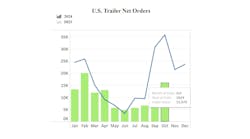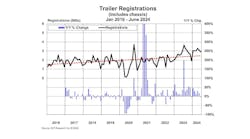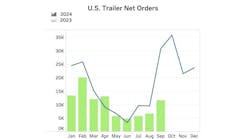U.S. manufacturing activity continued to expand in April, albeit at a slower pace, as the overall economy grew for the 108th consecutive month, according to the nation’s supply executives in the latest Manufacturing ISM Report On Business.
The April PMI registered 57.3%, a decrease of 2 percentage points from the March reading of 59.3%. For context, the February PMI, at 60.8%, set the 12-month high.
A PMI reading above 50% indicates that the manufacturing economy is generally expanding; below 50% indicates that it is generally declining.
In other measures:
- The New Orders Index registered 61.2%, a decrease of 0.7 percentage point from March but remaining at 60 or above for the 12th straight month, while the Backlog of Orders Index reached 62%, up 2.2 percentage points and the highest reading since May 2004 (63%)
- The Prices Index registered 79.3 percent in April, a 1.2 percentage point increase and the highest level since April 2011 (82.6%), indicating higher raw materials prices for the 26th consecutive month
- The Production Index registered 57.2%, a 3.8 percentage point decrease
- The Employment Index registered 54.2%, a decrease of 3.1 percentage points
- The Supplier Deliveries Index registered 61.1%, a 0.5 percentage point increase; and
- The Inventories Index registered 52.9 %, a decrease of 2.6 percentage.
Comments from the panel reflect continued expanding business strength, reported Timothy R. Fiore, CPSM, C.P.M., Chair of the Institute for Supply Management (ISM) Manufacturing Business Survey Committee.
“Consumption, described as production and employment, continues to expand, but has been restrained by labor and skill shortages,” the report said. “Inputs, expressed as supplier deliveries, inventories and imports, declined overall, due primarily to inventory reductions likely led by supplier performance restrictions. Lead time extensions, steel and aluminum disruptions, supplier labor issues, and transportation difficulties continue. Demand remains robust, but the nation’s employment resources and supply chains continue to struggle.”
Among the specific comments from survey respondents:
- “Business is off the charts. This is causing many collateral issues: a tightening supply chain market and longer lead times. Subcontractors are trading capacity up, leading to a bidding war for the marginal capacity. Labor remains tight and getting tighter.” (Transportation Equipment)
- “The recent steel tariffs have made it difficult to source material, and we have had to eliminate two products due to availability and cost of raw material.” (Fabricated Metal Products)
- “Demand is up for products. Commodity pricing for steel and other materials increased due to the proposed tariffs. We are seeing commodity futures coming down. A lot of suppliers are asking for increases, and the team is battling those requests.” (Machinery)
- "[The] 232 and 301 tariffs are very concerning. Business planning is at a standstill until they are resolved. Significant amount of manpower [on planning and the like] being expended on these issues.” (Miscellaneous Manufacturing)











